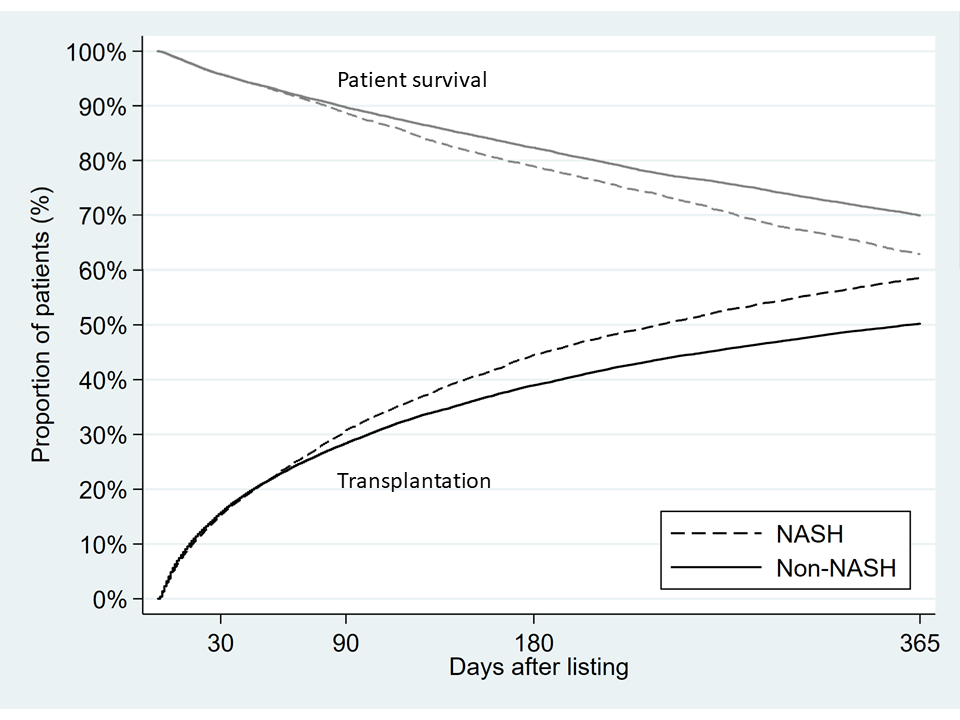Comorbidity Burden is Associated with Increased Waitlist Mortality Among NASH Patients
1Michigan Medicine, Ann Arbor, MI, 2General Surgery, Oregon Health & Science University, Portland, OR
Meeting: 2021 American Transplant Congress
Abstract number: 243
Keywords: Liver transplantation, Morbidity, Mortality, Waiting lists
Topic: Clinical Science » Liver » Liver: Recipient Selection
Session Information
Session Name: Liver Recipient Selection
Session Type: Rapid Fire Oral Abstract
Date: Monday, June 7, 2021
Session Time: 4:30pm-5:30pm
 Presentation Time: 4:40pm-4:45pm
Presentation Time: 4:40pm-4:45pm
Location: Virtual
*Purpose: Nonalcoholic steatotic hepatitis (NASH) is an increasing and common indication for liver transplantation. The association between increased comorbidity burden and risk of death on the waitlist remains unknown.
*Methods: Adult patients listed for liver transplant from 2004-2018 were identified from the UNOS-STAR file. NASH patients were identified by primary diagnosis code and compared with non-NASH patients. Patients who received exception points were excluded. Kaplan Meier estimates of waitlist survival and transplantation within 1 year of listing adjusting for listing MELD-Na score were compared among NASH and non-NASH patients. Subhazard ratios (SHR) were reported separately for days 0-60 and days 61-365 due to nonproportional hazards between cohorts over time. Iterative adjustment was performed for listing MELD-Na score, then patient characteristics and comorbidities (age, sex, BMI, diabetes, and kidney disease).
*Results: 61,859 patients were included, of which 12,689 (20.5%) had NASH. NASH patients were more likely to be older, female sex, with a higher burden of comorbidities, but lower MELD-Na scores at listing (Table). NASH patients had lower unadjusted risk of death within 60-days of listing (SHR 0.93, 95%CI 0.89-0.97) but higher risk of death between days 61-365 (SHR 1.12, 95%CI 1.08-1.17). Lower listing MELD-Na score among NASH patients explained the decreased risk of death between days 0-60 (aSHR 1.08, 95%CI 0.99-1.17) but not days 61-365 (aSHR 1.13, 95%CI 1.09-1.18). This is shown graphically in Figure. Further adjustment for patient characteristics and comorbidities resulted in similar risk of death between days 0-60 (aSHR 0.92, 95%CI 0.84-1.02) and lower risk between days 61-365 (aSHR 0.92, 95%CI 0.88-0.96).
*Conclusions: NASH patients are listed at lower MELD-Na scores than non-NASH patients. Despite lower listing MELD-Na, NASH patients demonstrated a higher risk of waitlist mortality from days 61-365, associated with higher comorbid disease burden. These data suggest that NASH patients have shorter window to transplantation. Careful assessment and management of comorbidities are particularly important in NASH patients.
| NASH | Non-NASH | ||
| Age | median (IQR) | 60 (54, 65) | 55 (48, 61) |
| Female sex | % | 50.4 | 37.1 |
| BMI | median (IQR) | 32 (29, 37) | 27 (24, 31) |
| Listing MELD-Na score | median (IQR) | 20 (15, 27) | 21 (15, 29) |
| Diabetes | % | 55.0 | 20.3 |
| Dialysis | At listing | 8.3% | 8.6% |
| At list removal | 20.1% | 18.8% |
To cite this abstract in AMA style:
Montgomery JR, Englesbe MJ, Connelly C. Comorbidity Burden is Associated with Increased Waitlist Mortality Among NASH Patients [abstract]. Am J Transplant. 2021; 21 (suppl 3). https://atcmeetingabstracts.com/abstract/comorbidity-burden-is-associated-with-increased-waitlist-mortality-among-nash-patients/. Accessed December 14, 2025.« Back to 2021 American Transplant Congress

